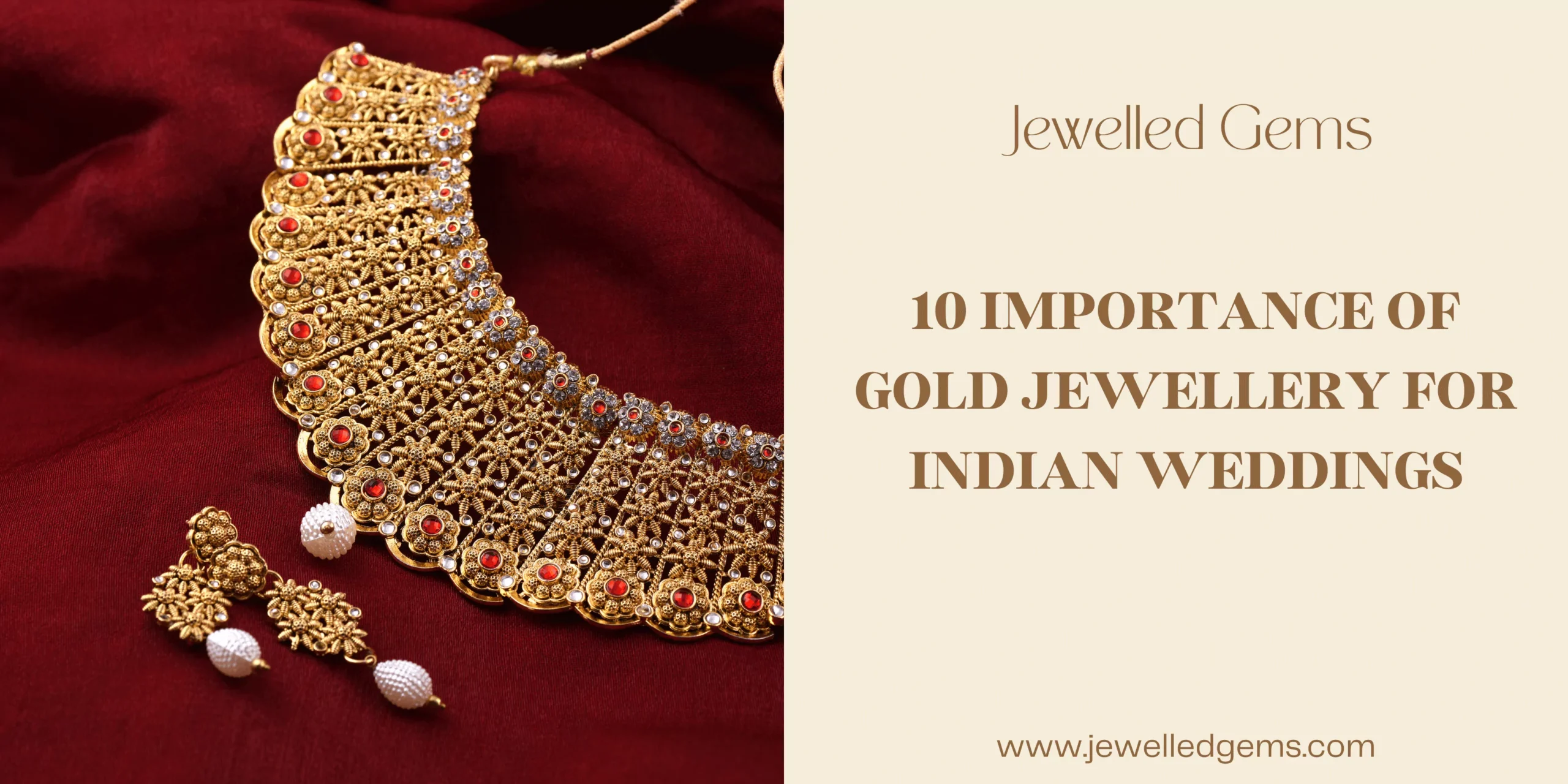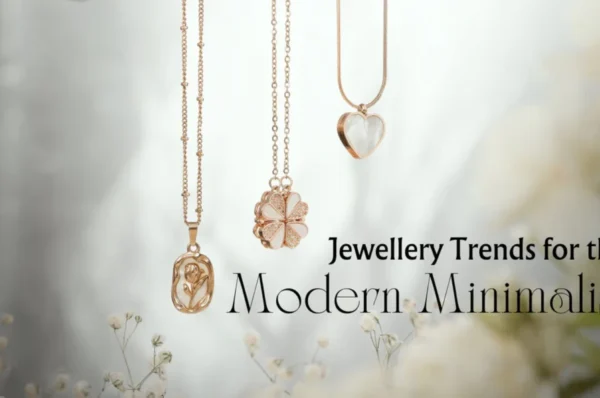10 Importance of Gold Jewellery for Indian Weddings
Gold jewellery holds a special place in Indian weddings, symbolizing tradition, wealth, and beauty. This precious metal has been cherished for centuries, and its significance in Indian culture remains unparalleled. Here, we delve into the profound importance of gold jewellery in Indian weddings, highlighting its cultural, economic, and emotional value.
1. Symbol of Prosperity and Wealth
In Indian culture, gold is not just a metal but a symbol of prosperity and wealth. It signifies the financial stability of the family and serves as a status symbol. The bride adorned with gold jewellery is seen as bringing wealth and good fortune to her new family. The more elaborate the jewellery, the greater the display of affluence, making it a crucial element in Indian weddings.
Gold’s association with wealth dates back to ancient times when it was used as currency and a means of trade. In Indian society, gold is considered a secure and stable form of wealth. Families invest in gold not just for adornment but as a way to safeguard their financial future. This cultural belief underscores the role of gold jewellery in weddings, where it is not merely ornamental but also a tangible representation of the family’s economic strength.
The symbolism of gold extends beyond the individual family to the broader community. In many Indian weddings, the amount and quality of gold jewellery worn by the bride are indicators of the family’s social status. Displaying a substantial amount of gold is a way to gain respect and admiration within the community. It reflects the family’s social standing and is a matter of pride and prestige.
2. Cultural Heritage and Tradition
Gold jewellery is deeply rooted in Indian tradition. Passed down through generations, these pieces often hold historical significance and family heritage. Wearing ancestral jewellery on the wedding day connects the bride to her family’s history, honoring their legacy. This tradition ensures that the cultural essence of gold jewellery is preserved and celebrated.
The craftsmanship of Indian gold jewellery is a testament to the country’s rich cultural heritage. Each piece tells a story, often inspired by mythology, folklore, and historical events. For instance, the intricate designs of temple jewellery are inspired by the architecture and iconography of South Indian temples. These pieces are not just beautiful but also carry a deep spiritual significance, linking the wearer to their cultural roots.
The tradition of passing down gold jewellery from one generation to the next creates a tangible link between the past and the present. These heirloom pieces are imbued with the memories and emotions of previous generations, making them more than just adornments. They are a way for families to preserve their history and ensure that their cultural legacy continues to be honored.
3. Investment and Financial Security
Gold is a reliable form of investment. Unlike other commodities, its value tends to appreciate over time, making it a secure investment. In Indian weddings, the jewellery given to the bride is often seen as a form of financial security. It can be sold or mortgaged in times of need, providing a financial cushion for the bride in her new life.
The economic stability provided by gold jewellery is particularly important in a country like India, where fluctuations in the economy can impact the financial well-being of families. Gold has historically been a hedge against inflation and economic instability. Its intrinsic value and liquidity make it a prudent choice for investment, especially in times of economic uncertainty.
The tradition of gifting gold jewellery during weddings is also a way for parents to ensure their daughter’s financial security. In many Indian families, the bride’s gold jewellery is seen as her personal wealth, which she can use in times of need. This practice not only provides a safety net for the bride but also reinforces the cultural belief in the importance of gold as a secure and valuable asset.
4. Enhancing the Bride’s Beauty
The aesthetic appeal of gold jewellery cannot be overstated. Crafted into intricate designs, these pieces enhance the bride’s beauty, complementing her attire and overall appearance. From heavy necklaces and bangles to delicate earrings and maang tikas, gold jewellery adds a touch of elegance and sophistication to the bridal look.
The role of gold jewellery in enhancing the bride’s beauty is multifaceted. Firstly, the bright yellow hue of gold complements the rich colors of traditional Indian bridal attire. Whether the bride is wearing a red lehenga or a vibrant saree, gold jewellery adds a radiant glow that enhances her overall appearance.
Secondly, the intricate designs of gold jewellery are a testament to the skill and artistry of Indian craftsmen. Each piece is meticulously crafted to enhance the bride’s features and complement her attire. For instance, a well-designed choker can highlight the neckline, while a pair of jhumkas can draw attention to the bride’s face. The attention to detail and craftsmanship of these pieces ensure that the bride looks her best on her special day.
5. Religious Significance
Gold jewellery also holds religious significance in Indian weddings. It is often used in various rituals and ceremonies. For instance, the Mangalsutra, a sacred necklace made of gold, is tied around the bride’s neck by the groom, symbolizing their marital bond. This ritual underscores the spiritual connection and the sanctity of marriage.
In Hindu weddings, gold is considered auspicious and is an integral part of many religious ceremonies. It is believed to purify and sanctify the occasion, bringing blessings and good fortune to the couple. The use of gold in religious rituals is not limited to weddings but extends to other important life events, reinforcing its sacred significance.
The Mangalsutra, in particular, is a powerful symbol of marital commitment and fidelity. Traditionally, it consists of a gold pendant strung on a black beaded chain. The gold pendant represents prosperity and protection, while the black beads are believed to ward off evil spirits. The ritual of tying the Mangalsutra around the bride’s neck is a deeply spiritual moment, signifying the couple’s union and the blessings of the divine.
6. Social Status and Community Respect
In many Indian communities, the amount and quality of gold jewellery worn by the bride are indicators of the family’s social status. Displaying a substantial amount of gold is a way to gain respect and admiration within the community. It reflects the family’s social standing and is a matter of pride and prestige.
The social implications of gold jewellery in Indian weddings are significant. The display of gold is not just about personal adornment but also about the family’s reputation and social standing. A bride adorned with an impressive array of gold jewellery is seen as a reflection of her family’s wealth and status. This display of affluence can enhance the family’s standing in the community and earn them respect and admiration.
In some regions of India, the amount of gold jewellery worn by the bride is also a way to honor guests and relatives. By displaying their wealth, families express their gratitude and respect for those who have come to celebrate the wedding. This practice reinforces the social bonds within the community and ensures that the wedding is a memorable and prestigious event.
7. Emotional Value and Sentiment
Gold jewellery carries immense emotional value. Often, the pieces worn by the bride on her wedding day are gifts from parents and grandparents, making them sentimental treasures. These pieces are cherished not just for their material value but for the love and blessings they embody. Wearing them on such a significant day adds to their emotional resonance.
The emotional significance of gold jewellery is deeply personal. Each piece often has a story behind it, whether it’s a gift from a loved one or an heirloom passed down through generations. For the bride, wearing these pieces on her wedding day is a way to honor her family’s love and support. It is a reminder of the special moments and memories shared with her loved ones.
Moreover, the emotional value of gold jewellery extends beyond the wedding day. These pieces become treasured keepsakes, carrying the memories and sentiments of the wedding day into the future. They are often worn on special occasions and handed down to future generations, ensuring that the emotional connection is preserved.
8. Cultural Diversity and Regional Variations
India is a land of diverse cultures, and this diversity is reflected in its jewellery designs. Each region has its unique style and craftsmanship. For example, South Indian weddings feature temple jewellery, characterized by intricate designs inspired by temple art. In contrast, North Indian weddings may showcase Mughal-inspired pieces with elaborate detailing. This cultural diversity adds richness to the tradition of gold jewellery in Indian weddings.
The regional variations in Indian gold jewellery are a testament to the country’s rich cultural tapestry. Each region has its distinct style, influenced by local traditions, history, and craftsmanship. For instance, the traditional jewellery of Kerala, known as “Kerala Kasavu,” is characterized by its simplicity and elegance, with designs inspired by nature and local folklore.
In contrast, the jewellery of Rajasthan is known for its opulence and grandeur. The traditional “Kundan” and “Polki” jewellery of this region are made using intricate techniques that involve setting uncut diamonds and gemstones in gold. These pieces are often elaborate and colorful, reflecting the rich cultural heritage of Rajasthan.
Similarly, the jewellery of Bengal is known for its delicate craftsmanship and intricate designs. The traditional “Nath” (nose ring) and “Sita Haar” (long necklace) are some of the iconic pieces from this region. These regional variations add to the richness and diversity of Indian gold jewellery, making it a unique and integral part of Indian weddings.
9. Symbol of Marital Status
In Indian weddings, certain pieces of gold jewellery symbolize the marital status of the bride. For instance, the Mangalsutra and toe rings are worn by married women as a symbol of their marital commitment. These pieces are not only significant on the wedding day but continue to hold importance throughout the married life of the woman.
The symbolism of gold jewellery in representing marital status is deeply ingrained in Indian culture. The Mangalsutra, as mentioned earlier, is a powerful symbol of marital commitment and fidelity. It is traditionally worn by married women as a mark of their marital status. The design and style of the Mangalsutra can vary depending on regional and cultural preferences, but its significance remains the same.
Similarly, toe rings, known as “Bichiya” in Hindi, are worn by married women in many parts of India. These rings are usually made of silver or gold and are worn on the second toe of both feet. They are considered a symbol of marital status and are often given to the bride by her mother-in-law during the wedding ceremony.
The practice of wearing these symbolic pieces of jewellery extends beyond the wedding day. They are worn by married women as a mark of their marital commitment and are considered auspicious. These pieces are a constant reminder of the sacred bond of marriage and the responsibilities that come with it.
10. Encouragement of Skilled Artisans
The demand for gold jewellery in Indian weddings supports a vast network of skilled artisans. These craftsmen, often working with techniques passed down through generations, create exquisite pieces that are celebrated worldwide. By investing in gold jewellery, families contribute to the preservation of traditional crafts and support the livelihoods of these artisans.
The craftsmanship of Indian gold jewellery is renowned for its intricacy and attention to detail. Skilled artisans use traditional techniques such as Kundan, Meenakari, and Filigree to create stunning pieces that are a blend of artistry and craftsmanship. These techniques have been passed down through generations, ensuring that the art of jewellery making is preserved and celebrated.
The demand for gold jewellery in Indian weddings plays a crucial role in sustaining the livelihoods of these artisans. By investing in gold jewellery, families contribute to the preservation of traditional crafts and support the artisans who create these beautiful pieces. This support is essential for the continuation of these traditional techniques and the preservation of India’s rich cultural heritage.
Moreover, the global appeal of Indian gold jewellery has led to a growing demand for these pieces internationally. Indian gold jewellery is celebrated for its intricate designs and craftsmanship, making it a popular choice for weddings and other special occasions worldwide. This global demand has further boosted the livelihoods of Indian artisans, ensuring that their skills and techniques are recognized and appreciated on a global scale.
Conclusion
Gold jewellery is an integral part of Indian weddings, embodying tradition, wealth, beauty, and emotional depth. Its significance extends beyond mere adornment, touching upon cultural heritage, financial security, and social status. As we celebrate the union of two souls, gold jewellery stands as a testament to the enduring values and rich traditions that define Indian culture.
The multifaceted importance of gold jewellery in Indian weddings is a reflection of its deep-rooted significance in Indian society. From its role as a symbol of prosperity and wealth to its cultural and emotional value, gold jewellery is a cherished part of Indian weddings. It enhances the beauty of the bride, symbolizes her marital status, and serves as a form of financial security. Moreover, it supports skilled artisans and preserves traditional crafts, contributing to the rich cultural heritage of India.
In conclusion, the importance of gold jewellery in Indian weddings cannot be overstated. It is a symbol of the country’s rich cultural heritage, a reflection of its economic stability, and a testament to the enduring values that define Indian society. As we continue to celebrate the union of two souls, gold jewellery will remain an integral part of this sacred tradition, embodying the beauty, prosperity, and cultural richness of Indian weddings.
10 FAQs About the Importance of Gold Jewellery for Indian Weddings
1. Why is gold jewellery considered important in Indian weddings?
Gold jewellery is considered important in Indian weddings because it symbolizes prosperity, wealth, cultural heritage, and tradition. It enhances the bride’s beauty, holds religious significance, and represents the family’s social status. Additionally, gold jewellery serves as a form of financial security and carries immense emotional value, making it an integral part of Indian wedding ceremonies.
2. How does gold jewellery reflect a family’s social status in Indian culture?
In Indian culture, the amount and quality of gold jewellery worn by the bride reflect the family’s social status. Displaying a substantial amount of gold is a way to gain respect and admiration within the community. It showcases the family’s wealth and social standing, contributing to their prestige and reputation.
3. What are the religious significance of gold jewellery in Indian weddings?
Gold jewellery holds significant religious importance in Indian weddings. It is often used in various rituals and ceremonies, such as the tying of the Mangalsutra, which symbolizes the marital bond between the bride and groom. Gold is considered auspicious and is believed to bring blessings and good fortune to the couple, making it an essential element in religious ceremonies.
4. Why is gold jewellery seen as a form of financial security for the bride?
Gold jewellery is seen as a form of financial security because it retains its value over time and can be sold or mortgaged in times of need. In Indian weddings, the jewellery given to the bride is often viewed as her personal wealth, providing a financial cushion and ensuring her financial stability in her new life.
5. How does gold jewellery enhance the bride’s beauty on her wedding day?
Gold jewellery enhances the bride’s beauty by complementing her attire and overall appearance. The intricate designs and bright yellow hue of gold jewellery add a touch of elegance and sophistication, making the bride look radiant and beautiful. Each piece is crafted to highlight the bride’s features and enhance her bridal look.
6. What emotional value does gold jewellery hold in Indian weddings?
Gold jewellery holds immense emotional value in Indian weddings. Often, the pieces worn by the bride are gifts from parents and grandparents, making them sentimental treasures. These pieces are cherished not just for their material value but for the love and blessings they embody. Wearing them on the wedding day adds to their emotional significance, creating lasting memories.
7. How does gold jewellery support skilled artisans and traditional crafts in India?
The demand for gold jewellery in Indian weddings supports a vast network of skilled artisans who use traditional techniques to create exquisite pieces. By investing in gold jewellery, families contribute to the preservation of traditional crafts and support the livelihoods of these artisans. This helps sustain the cultural heritage and ensures the continuation of these age-old techniques.
8. What are the regional variations in gold jewellery designs across India?
India’s diverse cultures are reflected in its gold jewellery designs, with each region having its unique style and craftsmanship. For example, South Indian weddings feature temple jewellery with intricate designs inspired by temple art, while North Indian weddings may showcase Mughal-inspired pieces with elaborate detailing. These regional variations add richness and diversity to the tradition of gold jewellery in Indian weddings.
9. How does gold jewellery symbolize marital status in Indian culture?
In Indian culture, certain pieces of gold jewellery, such as the Mangalsutra and toe rings, symbolize the marital status of the bride. The Mangalsutra is tied around the bride’s neck by the groom during the wedding ceremony, representing their marital bond. These pieces are worn by married women as a mark of their marital commitment and are considered auspicious.
10. Why is gold jewellery passed down through generations in Indian families?
Gold jewellery is passed down through generations in Indian families as a way to preserve cultural heritage and family legacy. These heirloom pieces often hold historical significance and emotional value, connecting the bride to her family’s history. Passing down gold jewellery ensures that the cultural essence and traditions associated with these pieces are honored and celebrated by future generations.




